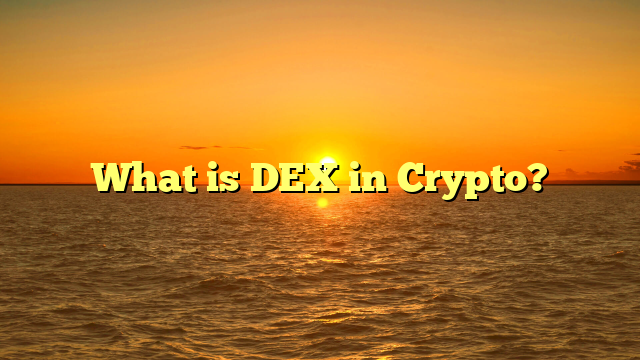What is DEX in Crypto?
DEX: A Dive into Decentralized Cryptocurrency Exchanges
The world of cryptocurrency is ever-evolving, constantly pushing the boundaries of traditional finance. DEXs offer a peer-to-peer (P2P) marketplace for trading cryptocurrencies.One innovation that embodies this spirit is the Decentralized Exchange, or DEX. Unlike their centralized counterparts (CEXs) that operate like stock exchanges with a central authority,
This shift in structure unlocks a unique set of advantages and challenges, making DEXs a fascinating aspect of the crypto ecosystem.
Decentralization: The Core of DEX
At the heart of a DEX lies the concept of decentralization. Traditional financial systems rely on intermediaries like banks and brokers to facilitate transactions. These entities hold user funds, verify identities, and enforce regulations. While this structure offers stability and security, it also introduces a single point of failure and potential censorship.
DEXs break free from this centralized model. Instead of relying on a single entity, they leverage smart contracts. These are self-executing contracts coded onto the blockchain, a distributed ledger technology that acts as a public record of all transactions. Smart contracts define the rules of a trade, automatically executing when pre-determined conditions are met. This eliminates the need for intermediaries, fostering a trustless environment where users retain complete control over their crypto assets.
Unveiling the Mechanics of a DEX
DEXs operate through a system of liquidity pools. These pools act as reservoirs of cryptocurrencies deposited by users, providing the necessary assets for buying and selling. When a trade occurs, the DEX interacts with these pools, swapping the desired cryptocurrencies based on pre-defined algorithms.
There are two primary models for liquidity pools:
-
Automated Market Makers (AMMs): This is the most common model, employed by DEX giants like Uniswap and SushiSwap. AMMs rely on mathematical formulas to determine exchange rates. Users supplying liquidity to the pool deposit equal value of two cryptocurrencies, creating a market for trading between them. The price of each cryptocurrency is then determined by the relative amounts present in the pool, following a constant product formula.
-
Order Book DEXs: These DEXs function similarly to traditional exchanges, where users place buy and sell orders specifying price and quantity. Matching engines then facilitate trades when a buy order meets a sell order at the same price. While offering more flexibility for experienced traders, order book DEXs typically have lower trading volumes compared to AMM-based counterparts.
The Rise of DEXs: A Statistical Glimpse
The DEX landscape is experiencing phenomenal growth. According to a Messari report, DEX trading volume surged from a mere $1 billion in April 2020 to a staggering $122 billion in April 2021, mirroring the crypto market’s bull run. While the market has since stabilized, DEXs continue to witness significant activity. DEX Metrics reports that leading DEXs like Uniswap, PancakeSwap, and Binance DEX still process billions of dollars in transactions weekly as of July 2021.
This rise in popularity can be attributed to several factors:
-
Transparency and Security: Since DEX transactions are recorded on the blockchain, they offer unparalleled transparency. Anyone can inspect the trade history, fostering trust and reducing the risk of manipulation.
-
Self-Custody: Unlike CEXs where users deposit funds, DEXs allow users to retain control of their private keys, granting them complete ownership of their crypto assets.
-
Accessibility: DEXs generally have lower barriers to entry, often not requiring Know Your Customer (KYC) procedures, making them attractive to users in regions with stricter financial regulations.
-
Innovation: The DEX ecosystem is fertile ground for innovation. New features like staking, yield farming, and decentralized governance models are constantly emerging, attracting users seeking advanced functionalities.
DEXs: Not Without Challenges
While offering unique advantages, DEXs also come with their own set of challenges:
-
Liquidity: For users trading less popular tokens, DEXs might suffer from lower liquidity compared to CEXs. This can lead to higher price slippage, meaning the difference between the expected price and the actual price at which a trade is executed.
-
Complexity: The user interface of DEXs can be more complex for beginners compared to user-friendly CEX platforms. Understanding concepts like liquidity pools and gas fees can be a hurdle for new entrants.
-
Scalability: As DEX usage grows, concerns regarding scalability arise. Blockchain processing times can become slow during periods of high activity, potentially impacting trade execution speeds.
-
Regulation: The decentralized nature of DEXs poses challenges for regulators. Finding the right balance between fostering innovation and mitigating potential risks associated with anonymity remains an ongoing debate.
The Future of DEXs: A Collaborative Landscape
Despite these challenges, the future of DEXs appears bright. Developers are constantly working on solutions to improve scalability and user experience.
The Future of DEXs: A Collaborative Landscape
Developers are constantly working on solutions to improve scalability and user experience. Layer 2 solutions, which are blockchain protocols built on top of existing blockchains like Ethereum, offer promising avenues for faster and cheaper transactions on DEXs.
Furthermore, the rise of Decentralized Autonomous Organizations (DAOs) is fostering a collaborative environment within the DEX ecosystem. DAOs are internet-native communities governed by collectively owned smart contracts, allowing DEX users to participate in decision-making processes related to platform development and upgrades.
Looking ahead, we can expect to see a convergence between DEXs and CEXs. CEXs might integrate DEX functionalities to offer users more control over their assets, while DEXs could adopt features that improve user experience and cater to institutional investors. This hybrid model could leverage the strengths of both approaches, fostering a more robust and inclusive crypto ecosystem.
The Verdict: DEXs – A Cornerstone of Decentralized Finance
Decentralized Exchanges represent a significant leap forward in the evolution of cryptocurrency. By empowering users with greater control and fostering a transparent trading environment, DEXs are a cornerstone of Decentralized Finance (DeFi). While challenges remain, ongoing innovation and collaboration within the crypto community promise to address these issues, paving the way for a future where DEXs become a mainstream alternative for trading digital assets.

